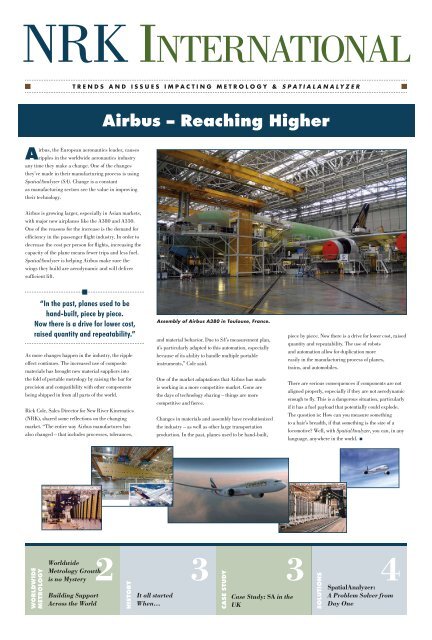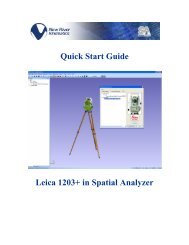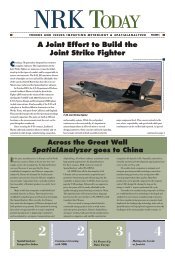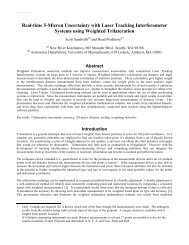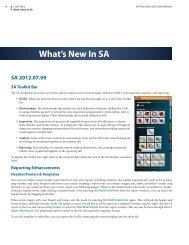Download (PDF) - New River Kinematics
Download (PDF) - New River Kinematics
Download (PDF) - New River Kinematics
- No tags were found...
You also want an ePaper? Increase the reach of your titles
YUMPU automatically turns print PDFs into web optimized ePapers that Google loves.
TRENDs and issues impacting metrology & spatialanalyzerIt All Started When...Two Engineers Decided to Write SoftwareIn 1994, Joe Calkins and Bob Salerno were workingon a robotics project together and discovered thatthe data provided by the measurement software wasn’tuseful. Since all of the instruments they were usingcame with their own individual software, data collatingbecame a chore. So they requested better measurementsoftware, only to find none existed. Salerno and Calkinsfounded <strong>New</strong> <strong>River</strong> <strong>Kinematics</strong> (NRK), then createda software package that eventually became known asSpatialAnalyzer (SA).From that idea came a solution that’s been adoptedacross the world, in a variety of industries. Two reasonsSA has been a success is that there was a need for bettergraphical measurement software and that NRK has aunique development philosophy. “We try to write thingsinto our software that benefit everyone. There are lots ofuses,” said Calkins.“We’re mechanical engineers who know how to writeprograms, not the other way around,” said Calkins.Actually, Calkins and Salerno are PhDs in mechanicalengineering, so that’s even more unusual. “We’re PhDsbut not entirely theoretical. We know that sometimestheories don’t work on the factory floor, and I think that’sone of the things that makes us different,” Salerno said.“We apply what we know about engineering to the realworld by using it for practical problem-solving.”NRK’s goal is to keep the software development processcustomer driven. “Often, customers do not truly knowwhat they want until they see an initial draft of theirparticular application. By proceeding forward withdevelopment in small steps, we’re able to craft ourproducts to best meet customer expectations,”Calkins said.NRK has a cohesive development team approach, whichhas the advantage of keeping the team small and alsoprecise. “Instead of throwing an army of programmersat a software task, we use a small team with extensiveknowledge. In addition, our staff has an engineering“We apply what weknow about engineeringto the real world…”background, which means we understand the actualengineering challenges our clients face,” Salerno said.“We wrote the code so that we can change a partwithout changing the whole thing, and we think that theright people are better than more people,” Calkins said.During the last SA user’s conference, the founders’intimate knowledge of the product was clear as theyhandled questions from the audience. No detail istoo small for them to know its function, origin andadaptability. NRK has engineers who understand thecustomer’s challenges actually writing the software.Will Austin works in customer relations for NRK.“We’re a very collaborative company, and we areresponsive pretty much around the clock. We have to bebecause our clients are in Japan, France, or anywhere,and their workday is different than ours,” he said.The result of this development cycle and round the clockservice is success for NRK and their customers. <strong>New</strong><strong>River</strong> <strong>Kinematics</strong> has produced SpatialAnalyzer, whichhas changed the industry of portable metrology. Theproduct and the company are a unique combination ofsuccess for their clients: a universal software solutionand a responsive company to back it up.In the founders’ pursuit of a solution to their ownproblem, they found solutions for lots of people. And, inan industry that always needs good problem solvers, theopportunity for worldwide growth is limitless.Join us for a case study in how SpatialAnalyzer (SA)has improved results for a customer. Sometimes,a real world situation brings home just how much atechnology can positively impact a business. As yousurely know, application is everything!Case Study: SA in the UKIn December 2008, 4G Metrology, based in Ireland,teamed up with Babcock Marine as an SA customerand provided extensive introductory training to theirpersonnel in early 2009. SA is currently being usedat the facility in Scotland to run both Leica 1201 andSokkia Net 05 total stations as well as handle all of thepost-processing and data analysis of critical dimensionalmeasurements. Duo-Touch ® II rugged tablet PCs areused to run SA and the instruments via aBluetooth connection.Alan Robertson, the Tech Lead for Babcock’s MarineDivision Design Services gave a history of how Babcockgot to where they are today. “Our predecessor toSpatialAnalyzer metrology software was SMX Insight.Like a lot of advanced users back in the late 1990s andearly 2000s, there wasn’t much we couldn’t do with itusing a laser tracker. However, as soon as we startedusing SpatialAnalyzer in 2003, we quickly realized itspotential – to broaden the type and increase the quality ofservice we could offer to our customers,” Robertson said.Due to this change in software, Babcock became ableBabcock’s Marine division is the major support partner to the Royal Navy.to support a whole range of new instruments. The othermajor change was an increased control and analysis ofmeasurements that was far more powerful.SA’s “Relationship Fitting soon became our new‘Best-Fit’ friend and a whole new world was opened up.We no longer required fixed points in order to tie-in toa component,” Robertson said. And he added jokingly“It’s what we had been ‘weighting’ for.” It’s good toknow engineers have a sense of humor about suchserious matters.3Back to the case study: Measuring direct to the modelis a great advantage. Robertson said that in the past, aset of pre-determined “hard points” would be selectedand these points would need to be measured andthen compared to the model. Often this was difficultas lines of sight were often obscured by scaffoldingor equipment. “Now we can pick and choose what tomeasure on-site which allows a much more flexibleapproach. After a unit or block is complete, we usecontinued on page 4
TRENDs and issues impacting metrology & spatialanalyzerSpatialAnalyzer:A Problem Solver from Day OneFrom the beginning, SpatialAnalyzer (SA) wasarchitected from the ground up to be a metrologysolution. Bob Salerno and Joe Calkins, the creators of thesoftware, both have PhDs in mechanical engineering, andthat’s why they understand what users need and how theirinstruments are used.“When measuring a physical property like angle, distanceor length, those observations get turned into coordinates.That’s the real nugget of what we do, turn observationsinto coordinates,” Salerno said.In Salerno’s role as a mechanical engineer andco-founder of <strong>New</strong> <strong>River</strong> <strong>Kinematics</strong> (NRK), he gets a lotof calls from clients in the aerospace and shipbuildingindustries for problem solving.“One of the reasons people call with a production crisisis that they are doing something like trying to get a partto fit, and can’t find the reason why it’s not working. Manytimes the problem is simply the result of transferring datafrom one measurement environment to another,”Salerno said.Another challenge in the industry is the changingtechnological environment. “Instrumentation is alwayschanging,” Salerno said. “10 years ago, laser trackersdominated, but now scanners are more common, and laserradar is finding more use.” It can be a challenge to findsolutions for all types of instrumentation.Each of these instruments brings a different set ofstrengths and weaknesses, but the software they use canbe universal with SpatialAnalyzer, which was designedwith these industry shifts in mind.“We know that it’s critical that our users understand theuncertainty associated with every coordinate. Tolerancesare getting tighter, more than ever before. Our clients say‘We need to know where this edge is, plus or minus 0.004inches.’ If you want to know that, you need a measurementsystem that not only provides the edge location, but doesso with acceptable uncertainty,” Salerno said.For engineers in manufacturing, this can mean lessrework and less waste. That’s one of NRK’s motivations,and also being able to create more compatibility in theindustry. That means that SA runs on arms, trackers andscanners, and that operators can be cross-trained to workSA with any instrument. The data is compatible and so arethe operators.The benefits of cross-training are often overlooked.“Having an operator know more than one instrumentincreases their creativity for whole systems. A tracker guycan bring his tracker tricks that he’s known for years, tousing an arm. He might be able to innovate in a way thatsomeone who was trained only on an arm might not thinkof it,” Salerno said. Some users have never hadinstrument-specific software, so they use SA and pick it upright away, and become flexible workers.What is rapidly making SpatialAnalyzer the de factoworldwide industry standard is that it’s an interface thatcan be used on any instrument. The user doesn’t need toknow the software of each brand and type of equipment;they can just jump between equipment. “This streamlinesdata collection and creates universal solutions on theproduction floor,” Calkins said.In the metrology industry, the GD&T standards are oftendesigned with the assumption of perfect conditions. Butin real life, as engineers are all too aware, conditions arenever perfect. So the right tools make all the difference.That’s one of reasons SA has become the industrystandard for engineering in large volume projects.<strong>New</strong> <strong>River</strong> <strong>Kinematics</strong> is now a company that solvesproblems for major international corporations. Theirclients include Boeing, Northrop Grumman, Airbus,and contractors for aerospace, shipbuilding and particleaccelerators across the country and throughout theworld. A wide selection of features allows for customizedsolutions from basic measurement to completelyautomated production processes. In an industry that relieson precision data, this small start-up company continuesto set the standard higher and tighter.NRK, who is headquartered in Williamsburg, Virginia,has employees based in different locations throughout theU.S. and in Europe. In addition, NRK has representativesin most other parts of the world through their extensivesales and support reseller network. NRK’s staff includesdevelopers, application engineers, trainers, sales andoperations personnel. The collaborative teamwork thathappens at the offices often includes problem-solvingsessions for clients. The custom engineering consulting isunusual, but standard for NRK.“We help our clients solve their problems – it’s part of therelationship we’ve built,” said Salerno.Part of the company’s philosophy is to serve the clientsby meeting or exceeding their needs. One of the waysthey do that is to create customized solutions. Often thesesolutions go on to become part of the software package ofSpatialAnalyzer. “Basically, our clients call us and tell uswhat kind of challenge they are facing. And we find a wayto make our software work for them. There’s so much wecan do to help our clients in this way,” Salerno said.continued from page 3‘relationships’ to ‘best fit’ the built unit to the model,” hesaid. “This allows for comparisons with other units sowe can best assemble them to the overall design. Usedcorrectly, this software can bring big savings in time andcosts by minimizing rework.”In terms of the best uses of SA, there are a number ofindustries who use it. But there continue to be new areasfor it to be applied to. Robertson said he sees SA’s USMNinterface (Unified Spatial Metrology Network) as a veryvaluable function. “The ability to determine at the clickof a button the uncertainties associated with a groupof measurements is of great importance in large-scaleprojects which require high accuracy.”His opinion is that future growth in control networksis likely due to being able to quite simply determine a“composite” set of measurements. “The composite setwith associated uncertainties for a set of points measuredfrom multiple stations is paramount moreover in theaerospace and ship-building industries.”In conclusion, this case study proves that: “Theintroduction of robotic total stations controlled by SA hasrevolutionized the DC processes within Babcock Marine.Using SA to set out control networks (using the USMNfunction) means quick, accurate and reliable set ups. Thetime taken to measure our units and blocks for the aircraftcarrier build is greatly reduced, and using SA allows theresults to be immediately available on site.”Sometimes thebenefits go bothways. “In additionto their utilizationof SA, the teamat BabcockMarine hasprovided ideasfor improvementsand new featuresin the total stationinterface,” said4Tom Fitzmaurice, of SA reseller 4G. SpatialAnalyzer’sfuture relies on the inherent flexibility of the product,along with great partners like Babcock Marine andreseller 4G.NRK In t e r nat iona lPublished by<strong>New</strong> <strong>River</strong> <strong>Kinematics</strong>www.kinematics.com


